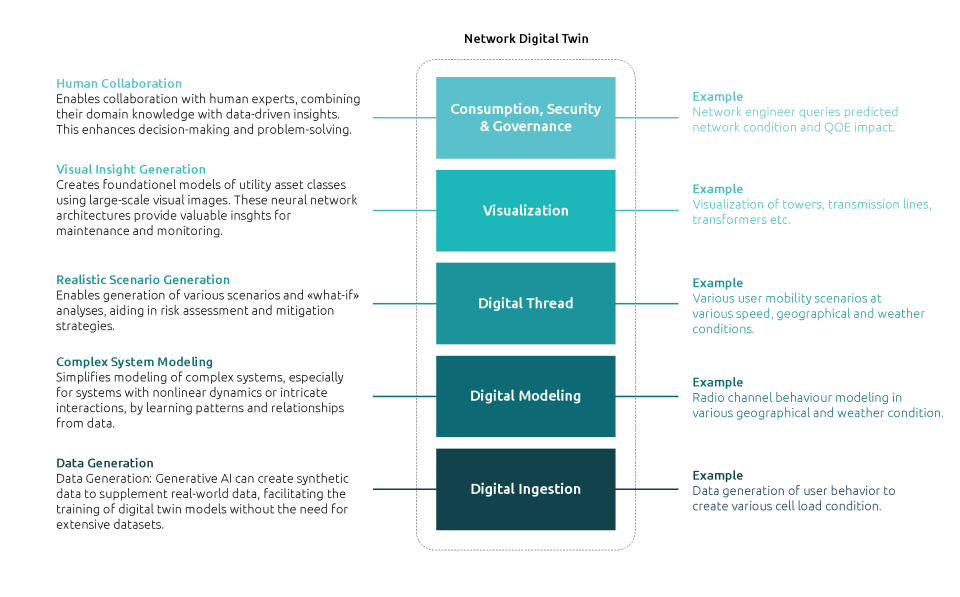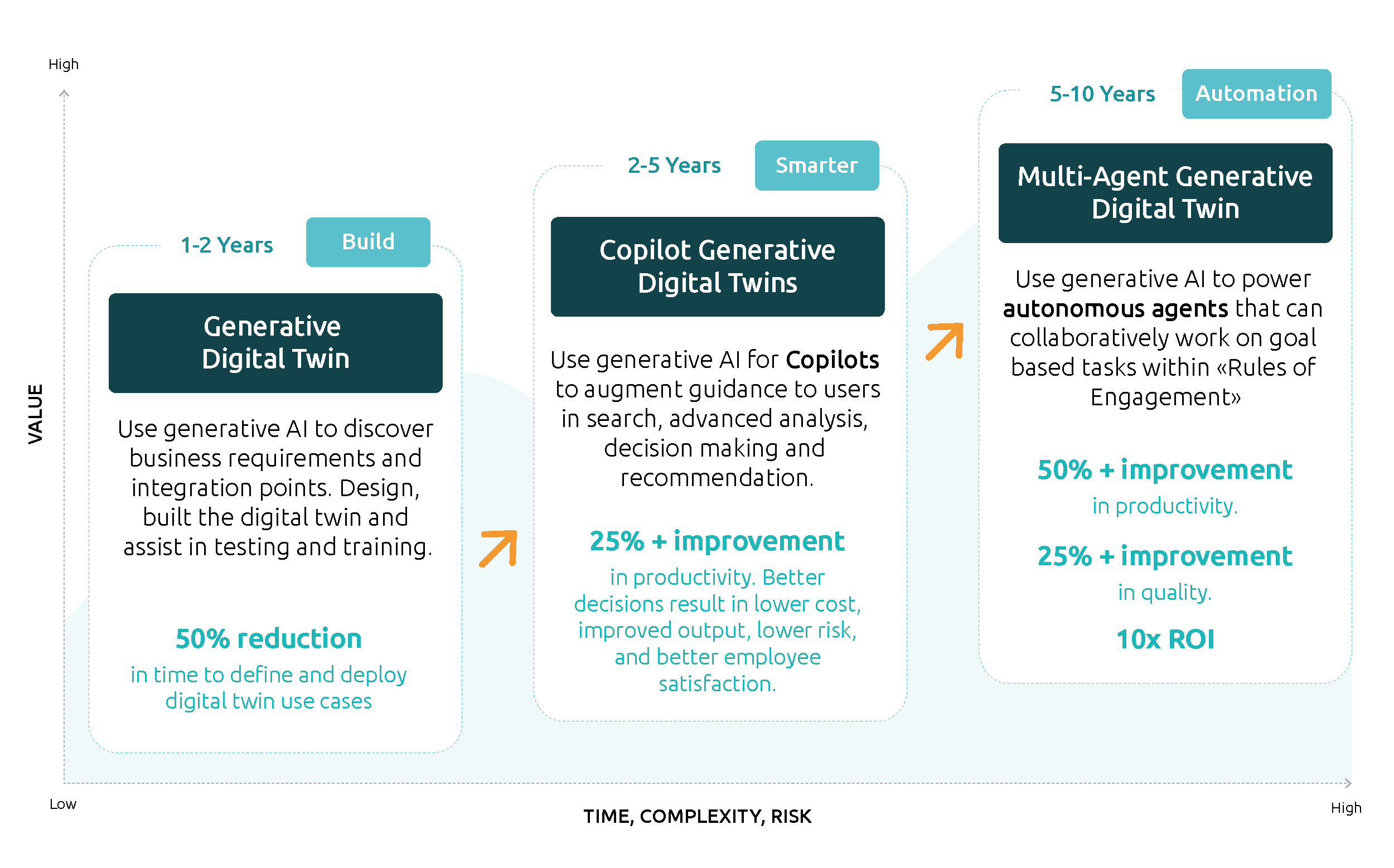Simplifying network digital twins for telcos with Gen AI
Understanding network digital twins
In telecommunications, network digital twins are transforming how network operators manage, optimize, and predict network performance.
A network digital twin is a highly detailed virtual replica of a real network that not only models the physical network elements of the network (eg. radio towers, routers, switches, and datacenter servers) but also the ‘invisible’ part of the network, like signals, coverage, interference, traffic behavior, and user mobility across frequency layers.
Network digital twins have various telco use cases, ranging from R&D to planning, deployment, and operations. For example, Verizon has reduced energy costs by over $100 million a year by using network digital twins to identify energy consumption anomalies across cell sites.
A digital twin provides a virtual lab for real time experimentation, before introducing changes to the physical network, thus minimizing risks. It can represent any scale or complexity, from a single network function or wireless protocol to the entire mobile network – and is used to test, analyze, optimize, monitor, or validate with minimal (or no) risk to the live network. Gartner predicts network digital twins will improve delivery time for requests by 20 percent across networks.
However, the volume of data, the dynamic nature of networks, and the need for scalability pose considerable challenges in building network digital twins. They are dauntingly complex to create and maintain. Enter generative artificial intelligence (Gen AI), which could potentially simplify and enhance network digital twin technology.
As stated by the Capgemini Research Institute , 96 percent of global telecom companies have Gen AI as a top priority on their agenda and 86 percent of them have already adopted it to some extent. In the context of network digital twins, Gen AI can be used to automate the generation and updating of these virtual models, making the process more efficient and less error prone.
Gen AI meets network digital twins
Gen AI is already being used to facilitate digital twin development and deployment. For example, Aira Technologies-has created RANGPT, an LLM-based capability for securely querying and controlling the RAN using Gen AI. With RANGPT, a wireless expert can analyze data, gain insights, iteratively experiment, and ultimately deploy code as a RAN application in a few hours.
Gen AI allows for simplifying the creation and maintenance of network digital twins in several ways.
- Data generation: Gen AI supports creating synthetic data to supplement real-world data, facilitating the training of digital twin models without extensive datasets. For example, a generative AI tool could produce data on user behavior to create various cell load conditions.According to Gartner, the use of Gen AI to create synthetic data is one rapidly growing area, and by 2026, 75 percent of businesses will use Gen AI to create synthetic customer data, up from less than five percent in 2023.
- Complex system modeling: Gen AI simplifies the modeling of complex systems, especially for systems with nonlinear dynamics or intricate interactions, by learning patterns and relationships from data. For example, a generative AI tool could model radio channel behavior in various geographical and weather conditions. Ericsson has built a city-scale digital twin using NVIDIA Omniverse, a Gen AI-enabled real-time virtual world simulation and collaboration platform for 3D workflows. It helps to accurately simulate the interplay between 5G cells and the environment, eg. physical phenomena and mobility aspects. This could help us develop faster, more reliable networks in future.
- Realistic scenario generation: Gen AI can be used to create various scenarios and ‘what-if’ analyses, aiding in risk assessment and mitigation strategies. For example, a tool could explore various user mobility scenarios at various speeds. Qualcomm has built a Gen AI-accelerated wireless digital twin that accurately represents the physical radio access network (RAN), to help operators answer these ‘what if’ questions, like how many users a network node can support while maintaining certain quality of service (QoS) parameters.-
- Visual insight generation: Gen AI enables creation of foundational models of utility asset classes, using large-scale visual images. These neural network architectures provide valuable insights for maintenance and monitoring. For example, we could use it to visualize towers, transmission lines, transformers and more.
- Human collaboration: Gen AI empowers a human expert to work more effectively with the network, combining their domain knowledge with data-driven insights from the network. This can enhance decision-making and problem-solving. For example, Gen AI could create a communication interface between humans and the network. Site engineers could query the network status through simple text like “how many mobile users are now making calls using this radio site?” and get a written response.

Generative AI can thus help to accelerate the creation of network digital twins, accurately representing their relevant functions and behavior, making them more accessible and affordable than ever before.
Like any other technology, the use of Gen AI for network digital twins has challenges that must be addressed before it can be deployed commercially. For example, it can produce toxic, biased, or hallucinated content. There are also data privacy and security risks, like the potential leakage of sensitive information or misuse of personal data.
Careful consideration of Gen AI’s risks is essential. This includes the need for frameworks to mitigate these risks, along with "guardrails," a set of predefined policies and operational protocols to regulate a model’s behavior and output.
These guardrails provide ethical boundaries, legal compliance, contextual appropriateness and security measures, preventing harmful or biased outputs and misuse of sensitive information and Amazon Bedrock Guardrails are examples of programmable guardrail frameworks.
Conclusion
Thanks to generative AI, the previously complex endeavor of developing network digital twins is becoming easier. Gen AI is changing how we build, maintain, and interact with these virtual replicas, opening doors to unprecedented network optimization and innovation. Gen AI-accelerated digital twins have improved ROI by 10x and reduced OPEX by up to 50 percent.
Capgemini’s view is that Gen AI will be gradually and steadily introduced using a hybrid AI approach. This combines the benefits of Gen AI with sources of structured knowledge and symbolic reasoning, as shown in the figure below, and, at each step of this journey, it will help to tangibly simplify network digital twins.
In the short term, the focus will be on using Gen AI to build parts of the network digital twin. In the medium term, it will help to make these twins smarter and act as copilots. Long term, we will see the rise of multi-agent generative twins for automating complex network management tasks.

Network digital twins have become an essential tool for CSPs, enabling them to test, optimize, and manage networks with minimal risk. It is now crucial for operators to build these digital twins quickly and efficiently. Generative AI simplifies their creation, maintenance, and optimization by automating processes, generating synthetic data, modeling complex systems, and enabling intuitive human-network interactions. Capgemini views GenAI as a transformative enabler of network digital twins, driving phased advancements toward smarter, autonomous network management solutions that enhance ROI and operational efficiency
What Next?
- Plan and prepare: Define objectives, assess existing infrastructure, and establish a robust data strategy by identifying key use cases, consolidating high-quality data and leveraging synthetic data through Generative AI. Identify gaps and ensure alignment with network goals.
- Build and pilot: Use generative AI to automate the creation and maintenance of the digital twin, integrate scalable tools and platforms, implement guardrails and security frameworks. Pilot the solution on a smaller scale, refine based on feedback, and train teams for effective adoption.
- Optimize and scale: Monitor key performance metrics through generative interface for human collaboration, continuously update the digital twin with real-time insights, and expand its scope across the network. Progress toward autonomous network management for enhanced ROI and operational efficiency.
We now stand at the crossroads of a technology transformation. Implemented correctly, Gen AI combined with digital twin technology will redefine the telecommunications landscape. But Gen AI’s benefits can only be truly realized with a proper strategy. To succeed, telecom companies must carefully define their policy frameworks and guardrails to use this new technology safely. Capgemini can help.
TelcoInsights is a series of posts about the latest trends and opportunities in the telecommunications industry – powered by a community of global industry experts and thought leaders.

